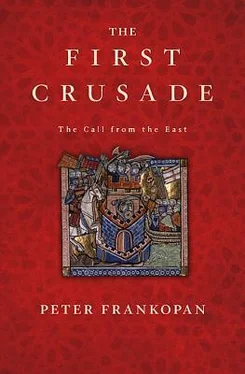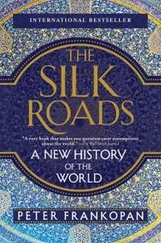The emperor, wrote his daughter, was like a helmsman guiding his vessel through endless battering waves. Scarcely had one wave broken than the next rolled towards him: ‘There was a never-ending succession of woes, an ocean of trouble, as it were – so that he was allowed no chance to breathe nor even rest his eyes’. 93Alexios had responded to this onslaught with extraordinary boldness.
The story of the First Crusade has been told many times before. The exploits of men like Bohemond, Godfrey of Bouillon and Raymond of Toulouse have passed from one generation to another for centuries. The names and deeds of Baldwin of Calderun and Achard of Montmerle, who failed to return, were preserved for posterity, to be remembered for their heroism and selflessness in trying to liberate the Holy City of Jerusalem.
Less well known are the names of those who caused the First Crusade. Yet Abu’l-Kasim, Çaka, Bursuk, Togortak and Nikephoros Diogenes should feature in any discussion of the expedition that reshaped medieval Europe. They brought Byzantium to the verge of collapse and forced Alexios to look to the west. The attacks, intransigence and revolts of these men led, ultimately, to the restoration of Christian control of Jerusalem more than 450 years after it had fallen to the Muslims.
But it is one man, above all others, who stands out. Alexios I Komnenos put in motion the chain of events that introduced the Crusades to the world. The call from the east was to reshape the medieval world, massively expanding the geographic, economic, social, political and cultural horizons of Europe. After more than 900 years in the gloom, Alexios should once again take centre stage in the history of the First Crusade.
Albert of Aachen - Historia Iherosolimitana , ed. and tr. S. Edgington (Oxford, 2007).
Anna Komnene - Alexiad , revised tr. P. Frankopan (London, 2009).
Baldric of Dol - Historia Jerosolimitana , in RHC , Occ. vol. 4, pp. 1–111.
Barber and Bate, Letters - Letters from the East: Crusaders, Pilgrims and Settlers in the 12th–13th Centuries (Farnham, 2010).
Bernold of Constance - Die Chroniken Bertholds von Reichenau und Bernolds von Konstanz , ed. I. Robinson (Hanover, 2003).
Ekkehard of Aura - Frutolfs und Ekkehards Chroniken und die Anonymen Kaiserchroniken, ed. F-J. Schmale and I. Schmale-Ott (Darmstadt, 1972).
Fulcher of Chartres - A History of the Expedition to Jerusalem 1095– 1127 , tr. F. Ryan (Knoxville, 1969).
Geoffrey Malaterra - De rebus gestis Rogerii Calabriae et Siciliae Comitis et Roberti Guiscardi Ducis fratris eius , ed. E. Pontieri, in RIS , 2nd edition (Bologna, 1927–8).
Gesta Francorum - Gesta Francorum et aliorum Hierosolimitanorum , ed. and tr. R. Hill (London, 1962).
Gregory VII, Register - The Register of Pope Gregory VII 1073–1095 , tr. H. E. J. Cowdrey (Oxford, 2002).
Gregory Pakourianos - P. Gautier, ‘Le typikon du sébaste Grégoire Pakourianos’, Revue des Etudes Byzantines 42 (1984), pp. 6–145.
Guibert of Nogent - Gesta Dei per Francos , ed. R. Huygens (Turnhout, 1986).
Hagenmeyer, Epistulae - Epistulae et chartae ad historiam primi belli sacri spectantes: die Kreuzzugsbriefe aus den Jahren 1088–1100 (Innsbruck, 1901).
Ibn al-Athir - The Chronicle of Ibn al-Athir for the Crusading Period from al-Kamil fi’l-Ta’rikh , Part one, tr. D. S. Richards (London, 2002).
John the Oxite - P. Gautier, ‘Diatribes de Jean l’Oxite contre Alexis Ier Comnène’, Revue des Etudes Byzantines 28 (1970), pp. 5–55.
John Skylitzes - Ioannis Scylitzae Synopsis historiarum , ed. I. Thurn (New York, 1973).
John Zonaras - Epitome Historiarum , ed. M. Pinder and T. Büttner-Wobst, 3 vols. (Bonn, 1841–97).
Katakalon Kekaumenos - Sovety i rasskazy Kekavmena , ed. and tr. G. Litavrin (Moscow, 1972).
Manuel Straboromanos - P. Gautier, ‘Le dossier d’un haut fonctionnaire d’Alexis Ier Comnène, Manuel Straboromanos’, Revue des Etudes Byzantines 23 (1965), pp. 168–204.
Matthew of Edessa - Armenia and the Crusades , tr. A. Dostourian (Lanham, 1993).
MGH , SS - Monumenta Germaniae Historica, Scriptores , 32 vols. (Hanover, 1826–).
Michael Attaleiates - Michaelis Attaliotae Historia , ed. I. Bekker (Bonn, 1853).
Michael the Syrian - Chronique de Michel le Syrien , ed. and tr. J-B. Chabot, 4 vols. (Paris, 1899–1910).
Miklosich and Müller - Acta et diplomata graeca medii aevi sacra et profana , 6 vols. (Vienna, 1860–90).
Nikephoros Bryennios - Nicephori Bryennii historiarum Libri Quattuor , ed. and tr. P. Gautier (Brussels, 1975).
Orderic Vitalis - The Ecclesiastical History of Orderic Vitalis , ed. and tr. M. Chibnall, 6 vols. (Oxford, 1967–80).
Patrologia Latina - Patrologia Latina , ed. J-P. Migne, 221 vols. (Paris, 1844–64).
Ralph of Caen - The Gesta Tancredi of Ralph of Caen , tr. B. Bachrach and D. Bachrach (Aldershot, 2005).
Raymond of Aguilers - Historia Francorum qui ceperunt Iherusalem , tr. J. Hill and L. Hill (Philadelphia, 1968).
RHC, Occ. - Recueil des Historiens des Croisades, Historiens Occidentaux , 5 vols. (Paris, 1841–95).
RHC, Or. - Recueil des Historiens des Croisades, Historiens Orientaux , 4 vols. (Paris, 1869–98).
RIS - Rerum Italicarum Scriptores .
Robert the Monk - Robert the Monk’s History of the First Crusade, Historia Iherosolimitana , tr. C. Sweetenham (Aldershot, 2006).
Theophylact of Ohrid - P. Gautier, ‘Discours de Théophylacte de Bulgarie’, Revue des Etudes Byzantines 20 (1962), pp. 93–130.
William of Apulia - La geste de Robert Guiscard , ed. and tr. M. Mathieu (Palermo, 1961).
William of Tyre - Chronicon , ed. R. Huygens, 2 vols. (Turnhout, 1986).
Introduction
1. Fulcher of Chartres, I.2.i, pp. 62–3. • 2. Robert the Monk, I.1, p. 79. • 3. Ibid., pp. 79–80. • 4. Fulcher of Chartres, I.3.iv, p. 66. • 5. Baldric of Dol, IV.1, p. 15. • 6. Robert the Monk, I.1, pp. 79–80. • 7. All the main accounts of Urban’s speech were written at the start of the twelfth century, after the Crusade. For some comments on the significance, see below, Chapter Twelve, pp. 200–1. • 8. Guibert of Nogent, I.1, p. 87; also Fulcher of Chartres, I.3.v–viii, pp. 66–7; Robert the Monk, I.2, p. 81; R. Somerville, The Councils of Urban II: Decreta Claromontensia (Amsterdam, 1972), p. 74. • 9. Robert the Monk, I.2, pp. 81–2; Fulcher of Chartres, I.4.iv, p. 68; Guibert of Nogent, II.5, p. 117. • 10. V. Tourneur, ‘Un denier de Godefroid de Bouillon frappé en 1096’, Revue belge de numismatique 83 (1931), pp. 27–30; cf. N. Bauer, ‘Der Fund von Spanko bei St Petersburg’, Zeitschrift für Numismatik 36 (1926), pp. 75–94. • 11. See, for example, J. Riley-Smith, The First Crusade and the Idea of Crusading (London, 1986), pp. 31ff. • 12. For the decree about Jerusalem that was passed at Clermont, see Somerville, Councils of Urban II , pp. 74, 124, and also R. Somerville, Papacy, Councils and Canon Law (London, 1990), pp. 56–65 and 325–37. Also Riley-Smith, First Crusade , pp. 13–30. • 13. The letter states that the Crusade force numbered 300,000 as it gathered at Nicaea in 1097, and just over 20,000 at the battle of Ascalon in September 1099, although this figure did not include the garrison at Jerusalem or other towns held at this time by Western knights. Barber and Bate, Letters , pp. 34–5. For the size of the Crusader army, see J. France, Victory in the East: A Military History of the First Crusade (Cambridge, 1993), pp. 122–42. • 14. Raymond of Aguilers, I, p. 18; Albert of Aachen, V.40, pp. 392–4. • 15. Albert of Aachen, III.28, p. 182. • 16. Ralph of Caen, 119, p. 135. • 17. See, for example, J. Riley-Smith, The First Crusaders 1095–1131 (Cambridge, 1997); M. Bull, Knightly Piety and the Lay Response to the First Crusade: The Limousin and Gascony (Oxford, 1993); France, Victory in the East ; T. Asbridge, The First Crusade: A New History (London, 2004). For surveys of the Crusades in general, C. Tyerman, God’s War: A New History of the Crusades (London, 2006), J. Phillips, Holy Warriors: A Modern History of the Crusades (London, 2010). • 18. J. Nesbitt, ‘The rate of march of crusading armies in Europe: a study and computation’, Traditio 19 (1963), pp. 167–82; A. Murray, ‘The army of Godfrey of Bouillon 1096–9: Structure and dynamics of a contingent on the First Crusade’, Revue Belge de Philologie et d’Histoire 70 (1992), pp. 301–29; B. Bachrach, ‘Crusader logistics: From victory at Nicaea to resupply at Dorylaion’, in J. Pryor (ed.), Logistics of Warfare in the Age of the Crusades (Aldershot, 2006), pp. 43–62. • 19. For example, S. Edgington, ‘Albert of Aachen reappraised’, in A. Murray (ed.), From Clermont to Jerusalem: The Crusades and Crusader Societies (Turnhout, 1998), pp. 55–67; J. France, ‘The use of the anonymous Gesta Francorum in the early twelfth century sources for the First Crusade’, in ibid., pp. 29–42; J. Rubenstein, ‘What is the Gesta Francorum and who was Peter Tudebode?’, Revue Mabillon 16 (2005), pp. 179–204. • 20. A. Vauchez, ‘Les composantes eschatologiques de l’idée de croisade’, in A. Vauchez (ed.), Le Concile de Clermont de 1095et l’appel à la Croisade (Rome, 1997), pp. 233–43; H. Möhring, Der Weltkaiser der Endzeit: Entstehung Wandel und Wirkung einer tausendjahrigen Weissagung (Stuttgart, 2000), and B. E. Whalen, Dominion of God: Christendom and Apocalypse in the Middle Ages (Cambridge, Mass., 2009). • 21. J. Bliese, ‘The motives of the First Crusaders: A social psychological analysis’, Journal of Psychohistory 17 (1990), pp. 393–411; G. Anderson, R. Ekelund, R. Herbert and R. Tollinson, ‘An economic interpretation of the medieval crusades’, Journal of European Economic History 21 (1992), pp. 339–63. • 22. C. Ottoni, F-X. Ricaut, N. Vanderheyden, N. Brucato, M. Waelkens and R. Decorte, ‘Mitochondrial analysis of a Byzantine population reveals the differential impact of multiple historical events in South Anatolia’, European Journal of Human Genetics 19 (2011), pp. 571–6. • 23. A. Johansen and D. Sornett, ‘Finite time singularity in the dynamics of the world population and economic indices’, Physica A 294.3–4 (2001), pp. 465–502, citing J. DeLong’s University of California, Berkeley ‘Estimating World GDP’ project. • 24. Bernold of Constance, p. 520. • 25. Anna Komnene, XIII.6, p. 373. • 26. Ia. Liubarskii, ‘Ob istochnikakh “Aleksiady” Anny Komninoi’, Vizantiiskii Vremennik 25 (1965), pp. 99–120; for Anna’s sources, actual and possible, see J. HowardJohnston, ‘Anna Komnene and the Alexiad ’, in M. Mullett and D. Smythe (eds.) Alexios I Komnenos – Papers (Belfast, 1996), pp. 260–302. • 27. R. Bedrosian (tr.) Aristakes Lastivertc’i’s History (New York, 1985), p. 64.
Читать дальше











